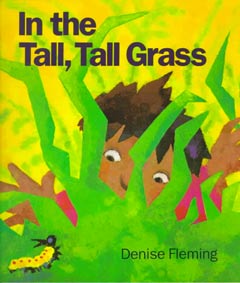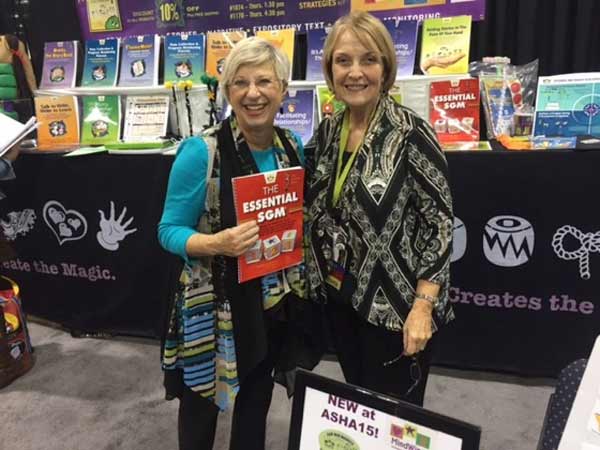Secure Checkout. FREE SHIPPING for Continental U.S. Orders over $60.
Menu
-
- Home
-
About Us
-
The Approach
-
Linking Language & Literacy
-
MindWing Learning
-
Learning Resources
-
SHOP
-
Blog
-
- About MindWing
- Our People
- Contact Us
- Your Account
- Login
-
United States (USD $)

Secure Checkout. FREE SHIPPING for Continental U.S. Orders over $60.
MindWing Concepts Blog

Kindergarten Activity: In the Tall, Tall Grass
March 25, 2016 1 Comment
 In the Tall, Tall Grass by Denise Fleming has always been a favorite of mine to use with kindergarten students. It follows the perspective of a caterpillar on a journey in the tall, tall grass. I found it especially helpful to reinforce the Action Sequence, Stage 2, of narrative language development, shown below from Braidy the StoryBraid manual. The pictures below show a center activity that proved very popular with the students. The icon templates were obtained from pages 140-141 of the Braidy the StoryBraid manual. 1. I made a pocket folder for all the materials to be stored in out of green construction paper, folding it in half and cutting the “grass” along one end. 2. I cut out the star icon from page 140 of the manual...
In the Tall, Tall Grass by Denise Fleming has always been a favorite of mine to use with kindergarten students. It follows the perspective of a caterpillar on a journey in the tall, tall grass. I found it especially helpful to reinforce the Action Sequence, Stage 2, of narrative language development, shown below from Braidy the StoryBraid manual. The pictures below show a center activity that proved very popular with the students. The icon templates were obtained from pages 140-141 of the Braidy the StoryBraid manual. 1. I made a pocket folder for all the materials to be stored in out of green construction paper, folding it in half and cutting the “grass” along one end. 2. I cut out the star icon from page 140 of the manual...

Another Classic: Dr. Seuss’ The Sneetches
March 21, 2016
 A previous blog (“Read Across America Day and Dr. Seuss Lesson,” 2/29/16) focused on the biography about Dr. Seuss. One of his selections mentioned was The Sneetches, published in 1961. Written during the 1960s during the civil rights struggle, this book demonstrates conflict between star-bellied Sneetches and those Sneetches who did not have stars. In a biography, it was stated that Ted Geisel showed through this story how he thought it was silly for people “to hate one another because they looked different” (p. 81, Who Was Dr. Seuss? by Janet Pascal). Below find The Sneetches outlined using five of the seven SGM Developmental Stages...
A previous blog (“Read Across America Day and Dr. Seuss Lesson,” 2/29/16) focused on the biography about Dr. Seuss. One of his selections mentioned was The Sneetches, published in 1961. Written during the 1960s during the civil rights struggle, this book demonstrates conflict between star-bellied Sneetches and those Sneetches who did not have stars. In a biography, it was stated that Ted Geisel showed through this story how he thought it was silly for people “to hate one another because they looked different” (p. 81, Who Was Dr. Seuss? by Janet Pascal). Below find The Sneetches outlined using five of the seven SGM Developmental Stages...

Spring Stories — The Legend of The Indian Paintbrush
March 18, 2016
 The Legend of The Indian Paintbrush (Legends Series) by Tomie dePaola
The Legend of The Indian Paintbrush (Legends Series) by Tomie dePaola
The following synopsis is taken from Goodreads
In spring, the hills and meadows of Texas and Wyoming are ablaze with the reds, oranges, and yellows of the Indian Paintbrush. How this striking plant received its name is told in an old Indian legend. Many years ago, when the People traveled the Plains, a young Indian boy had a Dream-Vision in which it was revealed that one day he would create a painting that was as pure as the colors of the evening sky at sunset. The boy grew up to become the painter of the tribe, but although he found a pure white buckskin for a canvas and made paints from the brightest flowers and the reddest berries, he could not capture the sunset...

MindWing Concepts joins Chapman University in celebrating Story Grammar Marker®!
March 16, 2016
 I was delighted to receive this picture from friend and colleague Dr. Judy Montgomery at the
I was delighted to receive this picture from friend and colleague Dr. Judy Montgomery at the  Kick-Off of “SGM® Week” at Chapman University in Orange, California. This picture was taken at the 2015 ASHA Convention in Denver and showcases our newest publication (at the time) The Essential SGM®. Judy has been interested in the SGM® and narrative development for many years and approached Maryellen three years ago about the need for a manual written especially for college professors of Communication Disorders and Special Education Programs. She volunteered to write the Foreword...
Kick-Off of “SGM® Week” at Chapman University in Orange, California. This picture was taken at the 2015 ASHA Convention in Denver and showcases our newest publication (at the time) The Essential SGM®. Judy has been interested in the SGM® and narrative development for many years and approached Maryellen three years ago about the need for a manual written especially for college professors of Communication Disorders and Special Education Programs. She volunteered to write the Foreword...

A Leprechaun Lesson for St. Patrick’s Day with Story Grammar Marker®
March 14, 2016

Cead Mile Failte (A Hundred Thousand Welcomes)!
I always enjoy trickster tales and have been amazed at the discussion and enthusiasm that these tales elicit from children. The tales from this folktale genre exists worldwide. So, with this in mind and St. Patrick’s Day on the horizon, I thought it would be fun to look at books involving leprechauns, those mischievous fairies from Irish folklore. A brief trip to my local library in Springfield, Massachusetts, netted many books sure to put a smile on your student’s face! One such tale is Clever Tom and the Leprechaun. Here is a link to a YouTube video of a reading of the book. I would begin by reviewing two words in the title: clever and leprechaun...

Understanding Novels / Chapter Books with SGM — Part 6
March 10, 2016
 This final section of analysis of The Big Wave by Pearl Buck begins with personification of the sea and extends the overall themes of friendship, resilience, overcoming obstacles and gratitude leading to new beginnings. The Critical Thinking Triangle® and the Complete Episode maps of the Story Grammar Marker® assist students in qualitative analysis of the plot to form opinions and apply the themes to their own lives. On pages 20 and 21 Jiya must obey and make a decision. Use two Critical Thinking Triangles to map these...
This final section of analysis of The Big Wave by Pearl Buck begins with personification of the sea and extends the overall themes of friendship, resilience, overcoming obstacles and gratitude leading to new beginnings. The Critical Thinking Triangle® and the Complete Episode maps of the Story Grammar Marker® assist students in qualitative analysis of the plot to form opinions and apply the themes to their own lives. On pages 20 and 21 Jiya must obey and make a decision. Use two Critical Thinking Triangles to map these...

 The Legend of The Indian Paintbrush (Legends Series) by Tomie dePaola
The Legend of The Indian Paintbrush (Legends Series) by Tomie dePaola